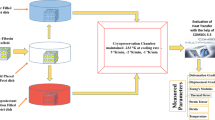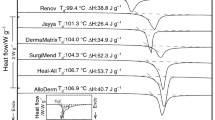Abstract
Cryopreservation technology is used for the storage of biological substances. The present work shows the effect of cryogenic temperature (230 °K) on graded PDMS scaffold degradation at the different rates of cooling (− 5, − 2 and − 1 °K/min). Different 2D structures of 5 × 5 PDMS scaffolds had been designed by variation of hole distance and hole diameter. Transient analysis of different structures was evaluated for defined rate of cooling by using of fully coupled heat transfer in solid and fluid along with solid mechanics physics. Five different parameters (temperature, stress, displacement gradient, strain tensor and deformation gradient) associated with scaffold degradation were observed in the presence of water at the different region of interest (ROI). The result shows that significant variation had been found in all parameters affecting the scaffold's degradation.
Access this chapter
Tax calculation will be finalised at checkout
Purchases are for personal use only
Similar content being viewed by others
References
Esmaeili S, Shahali M, Kordjamshidi A, Torkpoor Z, Namdari F, Samandari SS, Ghadiri Nejad M, Khandan A (2019) An artificial blood vessel fabricated by 3D printing for pharmaceutical application. Nanomed J 6(3):183–194
Leong KF, Chua SC, Sudarmadji N, Yeong WY (2008) Engineering functionally graded tissue engineering scaffolds. J Mech Behav Biomed Mater 1(2):140–152
Jammalamadaka U, Tappa K (2018) Recent advances in biomaterials for 3D printing and tissue engineering. J Functional Biomater 9(1):22
Gao Y, Hou M, Yang R, Zhang L, Xu Z, Kang Y, Xue P (2019) Highly porous silk fibroin scaffold packed in PEGDA/sucrose microneedles for controllable transdermal drug delivery. Biomacromol 20(3):1334–1345
Hashemzadeh H, Allahverdi A, Sedghi M, Vaezi Z, Tohidi Moghadam T, Rothbauer M, Fischer MB, Ertl P, Naderi-Manesh H (2020) PDMS nano-modified scaffolds for improvement of stem cells proliferation and differentiation in microfluidic platform. Nanomaterials 10(4):668
Antebi B, Asher AM, Rodriguez LA, Moore RK, Mohammadipoor A, Cancio LC (2019) Cryopreserved mesenchymal stem cells regain functional potency following a 24-h acclimation period. J Transl Med 17(1):1–13
Bahsoun S, Coopman K, Akam EC (2019) The impact of cryopreservation on bone marrow-derived mesenchymal stem cells: a systematic review. J Transl Med 17(1):1–29
Linville RM, DeStefano JG, Nerenberg RF, Grifno GN, Ye R, Gallagher E, Searson PC (2020) Long-term cryopreservation preserves blood–brain barrier phenotype of iPSC-derived brain microvascular endothelial cells and three-dimensional microvessels. Mol Pharm 17(9):3425–3434
Jesus AR, Meneses L, Duarte ARC, Paiva A (2021) Natural deep eutectic systems, an emerging class of cryoprotectant agents. Cryobiology 101:95–104
Bahari L, Bein A, Yashunsky V, Braslavsky I (2018) Directional freezing for the cryopreservation of adherent mammalian cells on a substrate. PLoS ONE 13(2):e0192265
Hunt CJ (2019) Technical considerations in the freezing, low-temperature storage and thawing of stem cells for cellular therapies. Transfusion Med Hemother 46(3):134–150
Jang TH, Park SC, Yang JH, Kim JY, Seok JH, Park US, Choi CW, Lee SR, Han J (2017) Cryopreservation and its clinical applications. Integr Med Res 6(1):12–18
Gurruchaga H, Del Burgo LS, Hernandez RM, Orive G, Selden C, Fuller B, Ciriza J, Pedraz JL (2018) Advances in the slow freezing cryopreservation of microencapsulated cells. J Control Release 281:119–138
Sun X, He S, Yao M, Wu X, Zhang H, Yao F, Li J (2021) Fully-physically crosslinked silk fibroin/poly (hydroxyethyl acrylamide) hydrogel with high transparency and adhesive properties for wireless sensing and low-temperature strain sensing. J Mater Chem C 9(6):1880–1887
Costa PF, Dias AF, Reis RL, Gomes ME (2012) Cryopreservation of cell/scaffold tissue-engineered constructs. Tissue Eng Part C Methods 18(11):852–858
Arai K, Murata D, Takao S, Verissiomo AR, Nakayama K (2020) Cryopreservation method for spheroids and fabrication of scaffold-free tubular constructs. PLoS ONE 15(4):e0230428
Theodoridis K, Müller J, Ramm R, Findeisen K, Andree B, Korossis S, Haverich A, Hilfiker A (2016) Effects of combined cryopreservation and decellularization on the biomechanical, structural and biochemical properties of porcine pulmonary heart valves. Acta Biomater 43:71–77
Carrillo JA, Fornasier M, Rosado J, Toscani G (2010) Downloaded 03/24/14 to 150.203.210.155. Redistribution subject to SIAM license or copyright; see http://www.siam.org/journals/ojsa.php. Copyright © by SIAM. Unauthorized reproduction of this article is prohibited, 42(1), 218–236
Hahn DW, Özisik MN (2012) Heat conduction. John Wiley & Sons
Bit A, Chattopadhyay H (2014) Numerical investigations of pulsatile flow in stenosed artery. Acta Bioeng Biomech 16(4)
Reis JMLD (2012) Effect of temperature on the mechanical properties of polymer mortars. Mater Res 15:645–649
Rödel M, Baumann K, Groll J, Gbureck U (2018) Simultaneous structuring and mineralization of silk fibroin scaffolds. J Tissue Eng 9:2041731418788509
Author information
Authors and Affiliations
Corresponding author
Editor information
Editors and Affiliations
Rights and permissions
Copyright information
© 2024 The Author(s), under exclusive license to Springer Nature Singapore Pte Ltd.
About this paper
Cite this paper
Deshmukh, K., Bit, A. (2024). Influence of Cryogenic Temperature on Degradation of Step-Graded Scaffold: A CFD Study. In: Singh, K.M., Dutta, S., Subudhi, S., Singh, N.K. (eds) Fluid Mechanics and Fluid Power, Volume 3. FMFP 2022. Lecture Notes in Mechanical Engineering. Springer, Singapore. https://doi.org/10.1007/978-981-99-6343-0_4
Download citation
DOI: https://doi.org/10.1007/978-981-99-6343-0_4
Published:
Publisher Name: Springer, Singapore
Print ISBN: 978-981-99-6342-3
Online ISBN: 978-981-99-6343-0
eBook Packages: EngineeringEngineering (R0)




